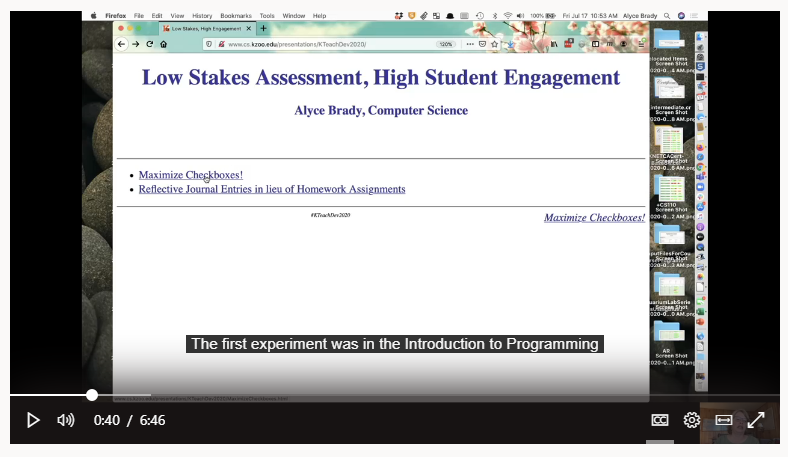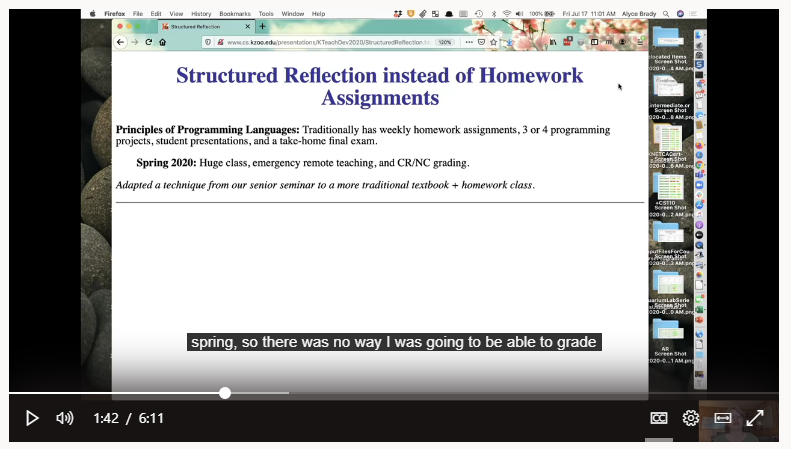From a pedagogical perspective, I am primarily influenced by practices of feminist pedagogy such as knowledge co-creation, empowerment, and community building. These three tenets each serve to deconstruct the professor/student hierarchy and have also become particularly important for my online teaching. In my classes, we begin with the recognition that each person, including the professor, experiences different privileges and oppressions and that these positionalities shape our perspectives on the world, and what we bring into the classroom. On the first day of class, I have the students break into groups to chat about engaging in respectful discussions surrounding difficult topics, and while online. We develop our guidelines as a class, thereby setting a tone of a less hierarchical classroom. Allowing the students to set guidelines on the first day signals to them that their voices are important and influential in the classroom. It also allows them to meet their classmates and to feel more comfortable speaking. Since enacting this practice, I have observed that students are much more confident speaking in class, and they are ready to speak immediately following the first day of class, whether in large or small groups. This first day exercise effectively removes the “awkward” period that a class sometimes needs before the students can trust one another and the professor enough to feel comfortable contributing. Particularly in the online setting, I have found that this exercise encourages them to recognize that they are all in the same “online boat,” so to speak, and that they share the experience of adapting to being online. This immediate commonality gives them a shared experience from which to build relationships and community.
Another way that I build community and empowerment, particularly across physical separation, is “check-ins.” I began these check-ins in the Fall 2020 quarter. At the beginning of each class, five minutes is set aside for students to check-in about how they are feeling. They can ask questions, talk about successes or challenges, or share something about their lives. Sometimes I leave it open to them, and sometimes I present a prompt, such as, “think of one thing you are proud of yourself for doing in the past week. It can be large or small, it could be as small as completing that household task you’ve been putting off, it could be as big as finishing that paper or having a difficult conversation with someone.” Then I ask if anyone would like to share their thoughts. I chose this example to write about specifically because the “thing you are proud of” check-in serves a purpose in addition to building community: it requires the students to actively think positively about themselves and to engage in a self-reflection that increases their self-esteem. It allows them to practice an exercise that has an immediate, positive effect on their mood. I felt that this empowerment was particularly significant in an online format in which students experience challenges beyond those of an in-person quarter, namely separation from peers and community, plus additional stresses, all of which may impact mental health.
I also use different models of experiential learning to allow students to direct their own learning. One such activity is group work. My pedagogical goals for group work are 1. To have the students teach each other and work through problems together, thereby enacting knowledge co-creation, and 2. To enable the students to build communities. Due to running classes online, I had to be more thoughtful when constructing group work activities and assessments. I’ve found that this has actually given me the opportunity to develop more specific goals and assessments for group work. In my classes, students are assigned to groups of four to five students for three-week sessions. Students work in their small groups typically every other class meeting. During small group, they complete a variety of guided exercises that I have developed related to the materials. I frequently pop-in to their breakout sessions to observe them and to offer myself as a resource to answer any questions that have come up in their discussion. They are also able to call me in to their breakout session by chatting me. After every three-week rotation, students must submit an evaluation sheet on which they are given a rubric for evaluating their peers and themselves (sample below). A recent change I have made for the Winter 2021 quarter is that providing thoughtful comments as well as a score is tied to each student’s own final score for that period (sample below). This should assure that I receive more evaluation sheets with comments and without having to remind students to submit them. You may notice that my own observations and score are weighted less than their peer scores in terms of their overall grade. I am again signaling a move away from the hierarchy of the professor-centered classroom and towards a recognition that myself and the students are partners in their education and assessment.
One final aspect of Fall 2020 that I will carry into Winter 2021 is something I learned from my students. About halfway through the fall quarter, I became concerned that three synchronous meetings each week, effectively the same schedule as in-person class meetings, was too taxing for the students given the virtual circumstances. I didn’t know if this was helping them, or too much for them. I asked them. They overwhelmingly expressed something that surprised me: they loved synchronous meetings. They said that because their lives are so restricted right now, in terms of where they can go, who they can see, what they can experience, that their days blend together. They could sleep until the afternoon, or they could get up and feel lost because they are undirected about where to start. They explained that synchronous class meetings give them a purpose to the day, a commitment of a place and time to show up, and a schedule for which they feel responsible. They told me that they need this structure, and that they were so happy my class provided it.
The best lesson I have learned is to continuously react, rethink, and adapt. Best wishes to everyone in the Winter 2021 quarter.
Sample Group Work Peer Evaluation Sheet
Instructions: Complete this form and turn it in to the assignment upload on Moodle by the Monday after groups switch (Mondays Week 4, Week 7, Friday Week 10). Your peer feedback is anonymous.
Give a score and comments for each group member, including yourself. Score as objectively as possible. Remember that your points for group work are factored in part by completing this sheet and giving reflective comments on how your peers and group worked together.
Your name: _____________________________ Group: __________
| Points |
| Between 15 and 17 points. Give this score if your peer went above and beyond your expectations for contribution to group work. |
| Between 12-14 points. Give this score if your peer did what was expected of them in contributing to the group. |
| Between 9-11 points. Give this score if your peer did more or less what was expected but required some management from other group members and/or did not exactly meet expectations in that or other ways. |
| Between 6-8 points. Give this score if your peer under-contributed to the group, did not meet expectations, or otherwise prevented the rest of the team members and the overall group from achieving their best work. |
| 0-5 points. Give this score if your peer was entirely absent, non-communicative, or for other circumstances that warrant a poor score. |
Peer name: ____________________________________
Points: ______
Comments:
Self-evaluation:
Points:____________
Comments:
Sample Group Work Rubric for Individual Scoring
***Although I have to give points in order to grade your assignments because I must give you a letter grade at the end of the quarter, I encourage you to think of these scores not as concrete evaluations of your abilities, but as opportunities for learning and growth.
| Submit peer feedback sheet with scores and written feedback for all group members and self (6 points possible) | |
| Average peer evaluation (17 points possible) | |
| Instructor evaluation based on observation, peer comments, and student self-assessment (10 points possible) |


